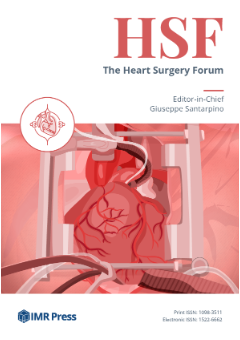Cite this article
1
Downloads
8
Citations
3
Views
Announcements
The Heart Surgery Forum (HSF) is published by IMR Press from Volume 28 Issue 9 (2025). Previous articles were published by another publisher under the CC-BY-NC licence, and they are hosted by IMR Press on imrpress.com as a courtesy and upon agreement.
Open Access
Article
Outcomes of De Vega versus Biodegradable Ring Annuloplasty in the Surgical Treatment of Tricuspid Regurgitation (Mid-term Results)
Halil Basel, Unal Aydin, Hakan Kutlu, Aysenur Dostbil, Melike Karadag, Dolunay Odabasi, Cemalettin Aydin
Heart Surg. Forum 2010, 13(4),
233–237;
https://doi.org/10.1532/HSF98.20091170
Published:
18 August 2010
Abstract
Purpose:The aim of this study was to compare De Vega semicircular annuloplasty and a new biodegradable ring annuloplasty technique in patients requiring surgical intervention for tricuspid valve disease with concomitant disease of the mitral valve.Methods:Between January 2004 and May 2008, 129 consecutive patients underwent annuloplasty procedures to correct tricuspid valve regurgitation during a concomitant mitral valve operation requiring replacement. Additionally, 24 patients underwent aortic valve replacement (AVR), 11 underwent coronary artery bypass grafting (CABG), 5 underwent AVR plus CABG, 3 underwent mitral valve replacement plus atrial septal defect (ASD) closure, and 2 underwent ASD closure. The patients in this study were assigned to 2 groups: Kalangos ring annuloplasty was performed in 67 patients (group 1), and De Vega semicircular annuloplasty was performed in the remaining 62 patients (group 2).Results:Both tricuspid valve repair techniques produced a low rate of complications; however, the number of patients who developed residual tricuspid regurgitation was significantly lower in group 1.Conclusion:The biodegradable ring annuloplasty technique may be used easily and safely in moderate and severe cases of tricuspid regurgitation; however, larger clinical series are necessary to confirm our promising results.

